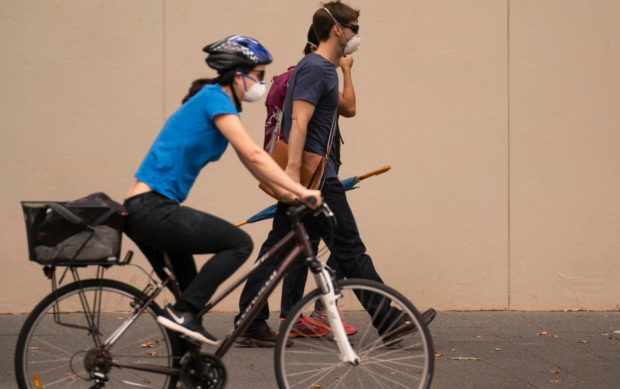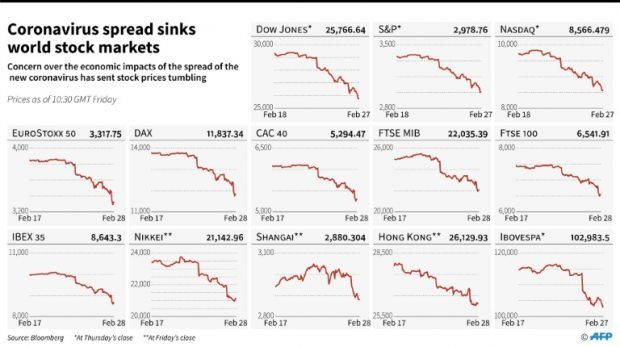Above: Blood sample with respiratory coronavirus positive
It is unusual for Popular Resistance to cover an issue two weeks in a row but the novel coronavirus (COVID-19) is developing rapidly, and there is a lot of misinformation about it. In the US, we are being misinformed by false information from the corporate media. K. J. Noh writes that “Instead of voicing support or encouraging solidarity—’We are Wuhan’—and commending the extraordinary efforts and sacrifices the Chinese have taken to fight a disease that, in the words of epidemiologist Zhong Nanshan, ‘all of mankind is facing,’ western corporate media have chosen to go all out to criticize and demonize China, sparing no effort to rekindle ugly, racist, orientalist, and dehumanizing tropes, using any perceived or imagined misstep, pretext, and shortcoming to tar China and the Chinese.”
We are also getting false information from the Trump administration. We don’t have an accurate count of the number of people who are infected because not enough people are being tested. The lack of testing could be due to an effort to keep the numbers of cases low so as not to create panic, especially in the financial markets. We review some of the new information including a new study that predicts the impact of its spread around the world.

The Panic In The Market Grows Despite Fed Action
The markets continued their downward trend last week after a brief upswing when Federal Reserve Chairman Jerome Powell signaled a coronavirus interest rate cut, the largest cut since the 2008 recession, and the insurance and pharmaceutical industries stocks rose after Biden’s Super Tuesday success.
While we view people’s health as the priority, the Trump administration seems focused on the economy, in particular the stock market. In presidential elections, the state of the economy is often a determining factor in whether a president is re-elected. Last week was the most volatile seven-day streak in nearly a decade, and many experts expect the wild market swings to persist. By the end of the week, the stock market had almost wiped out all month-to-date gains in both the S&P 500 and Dow Jones.
The misinformation by the Trump administration is backfiring. As people see the virus spreading rapidly, they are losing faith in the credibility of the government. Trust is critical to combatting the virus and to calming business and finance. Investors know the Fed’s action will do nothing to contain the virus or its impact on businesses. Many see the Fed’s action as a sign of panic that will not fix the global supply chains disrupted by the virus. The Fed cannot get the necessary supplies from Asia for US factories so an interest rate cut of 50 basis points or even more does not solve the real problems businesses are facing.
The Federal Reserve chairman claiming that the fundamentals of the economy are sound lacks credibility. Even before the coronavirus, economists were pointing to serious problems with corporate and personal debt as well as government debt and stagnant wages. The repo market has been in crisis since last fall. Many economists were already predicting a recession. The impacts of the disruptions in supplies and confidence caused by the virus are occurring in this shaky financial climate.

Virus Spreading, How Much Worse Can It Get?
COVID-19 continues to spread in much of the world, with the notable exception of China where there are reductions in its spread. The Atlantic reports that in “South Korea more than 66,650 people were tested within a week of its first case of community transmission, and it quickly became able to test 10,000 people a day. The United Kingdom, which has only 115 positive cases, has so far tested 18,083 people for the virus.” In the US, the CDC is not saying how many people have been tested. The Atlantic’s research could verify that only 1,895 people had been tested.
The US reports the total number of cases as of Sunday was at least 497 in 28 states with 19 deaths making the mortality rate nearly four percent. Several states have declared emergencies in response to the virus, including California, Florida, Indiana, Kentucky, Maryland, New York, Utah, and Washington. Pennsylvania has issued a disaster declaration and the city of Austin, Texas has issued a local disaster declaration. Austin’s high-tech South by Southwest conference was canceled. Amtrak canceled its nonstop Acela service between Washington, D.C. and New York City due to weakening demand resulting from concerns over the virus. Stanford has moved to online classes after a professor tested positive for COVID-19. The NBA and college basketball are continuing games but making plans to do so without fans. Police in Sacramento enforced a quarantine on a block after a person died of the virus.
The FDA announced that 2.1 million tests will be shipped to labs by Monday. Stephen Hahn, the FDA commissioner, told the media that manufacturers believe by the end of next week they could scale up to a capacity of 4 million additional tests. If this occurs and restrictions on testing are relaxed, then the number of known COVID-19 cases will greatly increase in the US.
This week, coronavirus cases around the world topped 105,000 with at least 3,558 deaths. Italy, following the approach taken by China, is planning lockdowns of large areas. The Italian government plans to lock down travel in Lombardy, a region of 10 million people in the north, which includes Milan, the nation’s financial hub. The Italian government also plans travel lockdowns in 11 provinces. People are being told to “absolutely avoid” travel to these areas except in emergency situations. Italy has at least 5,883 confirmed cases and at least 233 deaths.
Research by the Australian National University found that 15 million people could die from COVID-19 in the short term and it could cost the global GDP $2.4 trillion. These predictions were the lowest severity prediction of seven scenarios based on previous viruses. The highest severity analysis, based on the Spanish Flu pandemic, estimated a loss of $9 trillion of global GDP and 68 million deaths. Globally, about 3.4 percent of reported COVID-19 cases have died while the Spanish Flu of 1918 had a lower mortality rate, estimated by the WHO as between 2 and 3 percent. The contagion rate of COVID-19 is 4 to 7 while the Spanish flu was lower at 1.8.

Trump Administration’s Divisions With Health Officials Over Response
The Trump administration has had conflicts with health experts over how to respond to the virus. Associated Press reports that the Centers for Disease Control wanted to recommend that elderly and physically fragile people in the US be advised not to fly on commercial airlines, but according to a federal official, it was overruled by the White House.
This is one example of ongoing disputes between the White House and health officials. Alex Azar, the director of Health and Human Services, first heard about COVID-19 on January 3. The New York Times reports that by February health officials concerned about conflicting information coming from the government were ready to tell the president they had to be more blunt about the risks. While Trump was flying back from New Delhi, Dr. Nancy Messonnier, the director of the National Center for Immunization and Respiratory Diseases at the Centers for Disease Control and Prevention, told reporters “The disruption to everyday life might be severe.” She described how schools might have to close, conferences canceled, and businesses might make employees work from home.
Stocks plummeted and the news put out apocalyptic stories. When Trump landed, the Times reports, he was furious. This was part of “a raging internal debate about how far to go in telling Americans the truth.” Government scientists and health officials wanted aggressive action and clear warnings but Trump was concerned about spooking financial markets and inciting panic. The president’s message was “We have it under control. It’s going to be just fine” and “By April, you know, in theory, when it gets a little warmer, it miraculously goes away.”
When he appeared at the CDC on March 6, Trump expressed concerns about the numbers of cases going up if people on a cruise ship were allowed to leave the ship. He said he would prefer if the people stayed on the ship to keep those numbers down, even though health officials said that would make the problem worse.
In fact, things were not under control, Azar told a congressional hearing that he needed at least 300 million respirator masks for health care workers, but the national emergency stockpile had only 12 million, and many of those had expired. The CDC distributed a flawed coronavirus test, causing weeks of delay in urgently-needed testing. Then, a whistle-blower claimed that workers from HHS had been sent to greet people returning from China without the personal protective gear required for anyone coming into contact with potentially-exposed patients.
The misinformation continued when Trump ignored official advice to isolate people and said people should work if they had the virus. Vice President Pence, who was appointed chair of the Coronavirus Task Force, added to the problems with mixed messages of his own including promising more tests before they were available.

The Coronavirus Is A Plague Of Neoliberal Capitalism
As we pointed out in our last newsletter, the US healthcare system, rules for sick leave and other policy decisions have made the country unprepared for the COVID-19. Robert Urie goes further and describes it as a neoliberal plague. He points out how widespread economic marginalization and a lack of paid time off will result in contagious workers spreading the virus. He describes it as a “public health disaster by design” asking “how would any substantial portion of the 80 percent of the population that lives hand-to-mouth be effectively quarantined when losing an income creates a cascade effect of evictions, foreclosures, starvation, repossessions, shut-off utilities, etc.? “
Further, under the capitalist model, scarcity creates profit. This economic logic leads to fewer virus test kits, vaccines, and basic sanitary aids. This approach is consistent with the US healthcare system which is based on profits, not health. A true public health response would make evaluation, testing, and treatment of COVID-19 readily available and free to all regardless of insurance status.
Neoliberalism is coming home to roost in the COVID-19. But, are any candidates for office saying it? Are any Democrats pointing out that COVID-19 is a strong argument for national improved Medicare for all, paid sick leave and a stronger social safety net? The only candidate who has put forward a solid plan is Howie Hawkins who just won the Green Party primary in California. He urges a crash program for testing, care for those who are ill and protection for healthcare workers as well as funding for paid sick leave. In the long run, he urges Medicare for all through a community-controlled public health system, universal national paid sick leave policy and socializing the pharmaceutical and medical supply industries as public utilities
In addition to confronting the crisis of the COVID-19, we need system change so future epidemics can be better handled, public health protected and the economy can serve all of us, not just those who profit from disasters.

